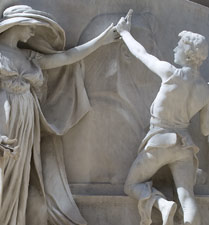New Connections appear every Wednesday. Sign up for a reminder.
Egyptian art curator Dorothea Arnold marvels at the survival and preservation of cultural artifacts in today's culture of obsolesence.
 1280852
1280852 12781024
12781024 6161024
6161024 1280961
1280961 10241024
10241024 1280914
1280914 1280948
1280948 5001024
5001024 7861024
7861024 9771024
9771024 8851024
8851024 1280853
1280853 1280823
1280823 11681024
11681024 7181024
7181024 1280969
1280969 12701024
12701024 9201024
9201024 11301024
11301024 9511024
9511024 1280852
1280852
I'm Dorothea Arnold from the department of Egyptian art at the Metropolitan Museum.
As we live today, we constantly throw things away, so it is even more astonishing that things survive.
Since I'm dealing a lot with objects that are at least three thousand and even then four thousand and five thousand years old the question, "how does all this survive?" comes up again and again. "How could it survive for so long?"
Textiles that are in such prime condition that you could use them for your bedding. And this is only possible because of the very dry climate in Egypt.
Natural disasters like Pompeii which was covered by the eruption, then excavated. And this beautiful bed chamber is in a condition almost like it must have been when people used it.
If there was human destruction like in the case of the female pharoah Hatshepsut
whose sculpture was completely smashed on the commission of her successor, thrown into a quarry for several centuries
discovered and painstakingly reassembled.
Or there is the famous piece in the attic. The piece that has been neglected, and that somebody comes, sees what it is, and it comes back to light.
Another important cause is that pieces go from generation to generation. So for instance this famous painting by Rembrandt was originally commissioned by somebody from the Rufo family in Messina in Sicily, and went then from generation to the next generation to the next generation.
And for a museum especially many, many collectors are involved in the survival of the works of art that we see here.
There is one item in this history: people. There must have been people who preserved bodies in ancient Egypt. Wrapped them up, adorned them, put them into coffins. So this kind of pious treating was absolutely necessary.
But it's not only the physical pieces that survive, there's something important and that is the survival of the images. Images have a tenacity that is quite astonishing.
For centuries the original Three Graces has been lost. What we have are copies from Roman times and then when these sculptures were found in Renaissance Italy and around the Mediterranean
there was a new revival of appreciations by the use of that image.
The Sphinx as an image became almost a symbol of ancient Egypt and so it became a symbol of ancient Egyptian thinking.
This superhuman being was a kind of sign of survival through time.
This memorial was for a very young dying sculptor
and you see what he was sculpting was a sphinx. Here we have the survival of the Egyptian sphinx image into the nineteenth-century.
Because it is the sign of the Egyptian deep thinking about death and about survival. So this is a very good example that an image has suddenly that power and spreads and just doesn't
die.
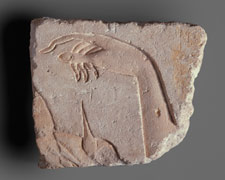 |
 |
 |
 |
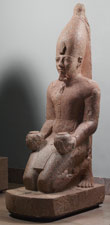 |
 |
 |
 |
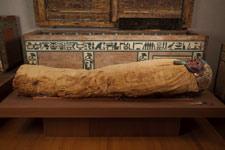 |
 |
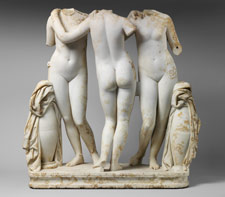 |
 |
 |
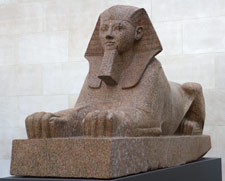 |
 |
Works of art in order of appearanceLast Updated: June 22, 2015. Not all works of art in the Museum's collection may be on view on a particular day. For the most accurate location information, please check this page on the day of your visit. |
||
 |
A Royal Hand New Kingdom, Dynasty 18, reign of Akhenaten, ca. 1349–1336 b.c. Egyptian Limestone, traces of paint Gift of Norbert Schimmel, 1985 (1985.328.1) More information: The Collection Online Not on view
|
 Egyptian ArtFirst Floor
Egyptian ArtFirst Floor |
 |
Seated woman with tattoos Predynastic, Naqada II, ca. 3650–3300 b.c. Egypt, Northern Upper Egypt, Naqada Clay plaster, resinous organic material, paint, malachite Rogers Fund, 1907 (07.228.71) More information: The Collection Online Not on view
|
 Egyptian ArtFirst Floor
Egyptian ArtFirst Floor |
 |
Linen shirt New Kingdom, Early Dynasty 18, reign of Thutmose II–Early Joint reign, ca. 1492–1473 b.c. Egyptian Linen Rogers Fund, 1936 (36.3.54) More information: The Collection Online Not on view
|
 Egyptian ArtFirst Floor
Egyptian ArtFirst Floor |
 |
Fresco wall painting in a cubiculum (bedroom) from the Villa of P. Fannius Synistor at Boscoreale ca. 40–30 b.c.; Late Republican Roman Plaster Rogers Fund, 1903 (03.14.13) More information: The Collection Online Not on view
|
 Greek and Roman ArtFirst Floor and Mezzanine
Greek and Roman ArtFirst Floor and Mezzanine |
 |
Large Kneeling Statue of Hatshepsut New Kingdom, Dynasty 18, Joint reign of Hatshepsut and Thutmose III, ca. 1473–1458 b.c. Egyptian Granite Rogers Fund, 1930 (30.3.1) More information: The Collection Online Not on view
|
 Egyptian ArtFirst Floor
Egyptian ArtFirst Floor |
 |
Sleeping Boy ca. 1774 Philippe-Laurent Roland (French) French (modeled in Rome) Terracotta, painted white Wrightsman Fund, 1990 (1990.206) More information: The Collection Online Not on view
|
 European Sculpture and Decorative ArtsFirst Floor
European Sculpture and Decorative ArtsFirst Floor |
 |
Aristotle with a Bust of Homer 1653 Rembrandt (Rembrandt van Rijn) (Dutch) Oil on canvas Purchase, special contributions and funds given or bequeathed by friends of the Museum, 1961 (61.198) More information: The Collection Online Not on view
|
 European PaintingsSecond Floor
European PaintingsSecond Floor |
 |
Juan de Pareja (born about 1610, died 1670) 1650 Diego Rodríguez de Silva y Velázquez (Spanish) Oil on canvas Purchase, Fletcher and Rogers Funds, and Bequest of Miss Adelaide Milton de Groot (1876–1967), by exchange, supplemented by gifts from friends of the Museum, 1971 (1971.86) More information: The Collection Online Not on view
|
 European PaintingsSecond Floor
European PaintingsSecond Floor |
 |
Mummy of the Chief Treasurer Ukhhotep Dynasty 12 (ca. 1991–1786 b.c.) Egyptian; From Meir Wood, gold leaf, Egyptian alabaster, obsidian, and various organic materials Rogers Fund, 1912 (12.182.132) More information: The Collection Online Not on view
|
 Egyptian ArtFirst Floor
Egyptian ArtFirst Floor |
 |
Bark Painting 1940–50s Ingura people, Groote Eylandt, Northern Territory, Australia Bark, paint The Michael C. Rockefeller Memorial Collection, Bequest of Nelson A. Rockefeller, 1979 (1979.206.1462) More information: The Collection Online Not on view
|
 Arts of Africa, Oceania, and the AmericasFirst Floor
Arts of Africa, Oceania, and the AmericasFirst Floor |
 |
Marble statue of the Three Graces 2nd century a.d.; Roman Marble Purchase, Philodoroi, Lila Acheson Wallace, Mary and Michael Jaharis, Annette and Oscar de la Renta, Leon Levy Foundation, The Robert A. and Renée E. Belfer Family Foundation, Mr. and Mrs. John A. Moran, Jeannette and Jonathan Rosen, Malcolm Hewitt Wiener Foundation and Nicholas S. Zoullas Gifts, 2010 (2010.260) More information: The Collection Online Not on view
|
 Greek and Roman ArtFirst Floor and Mezzanine
Greek and Roman ArtFirst Floor and Mezzanine |
 |
The Judgment of Paris possibly ca. 1528 Lucas Cranach the Elder (German) Oil on wood Rogers Fund, 1928 (28.221) More information: The Collection Online Not on view
|
 European PaintingsSecond Floor
European PaintingsSecond Floor |
 |
[The Pyramids and the Sphinx] 1860s–70s, printed ca. 1870 Félix Bonfils (French) Albumen silver print Gift of Daniel Wolf, in memory of Diane Wolf, 1976 (1976.561.2) More information: The Collection Online Not on view
|
 PhotographsSecond Floor
PhotographsSecond Floor |
 |
Sphinx of Hatshepsut New Kingdom, Dynasty 18, reign of Hatshepsut, ca. 1473–1458 b.c. Egyptian Red granite with traces of blue and yellow paint Rogers Fund, 1931 (31.3.166) More information: The Collection Online Not on view
|
 Egyptian ArtFirst Floor
Egyptian ArtFirst Floor |
 |
The Angel of Death and the Sculptor from the Milmore Memorial 1889–93; this carving, 1921–26 Daniel Chester French (American) Marble Gift of a group of Museum trustees, 1926 (26.120) More information: The Collection Online Not on view
|
 American Paintings and SculptureFirst and Second Floors
American Paintings and SculptureFirst and Second Floors |
© 2011 The Metropolitan Museum of Art |
||




